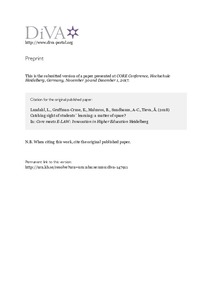Catching sight of students´ learning: a matter of space?
Lundahl Lisbeth; Gruffman-Cruse Ewa; Malmros Bengt; Sundbaum; Ann-Christin; Tieva Åse
https://urn.fi/URN:NBN:fi-fe2021042825310
Tiivistelmä
Based on a two-year study of a development project aiming to enhance students ́ learning in a natural science course by making their understanding more visible to themselves and their teachers, this paper analyzes the role of physical space in this context. Data were collected through systematic observations, photo and film documentation, student surveys, interviews with students and teachers, and also from students ́ examination results over an extended period. Previously, the course used traditional teaching methods and spaces. The students found the contents difficult, and the average examination results were poor. The teachers developed more student-active working methods, challenging students to make their understanding visible. However, the course literature and type of examination tasks remained unchanged, allowing for comparisons over time. The instruction took place in a large, innovative "flex-room", equipped with touchscreens, whiteboards, highly accessible technology and flexible furniture, allowing for increased student communication and feedback. The teachers could interact with student groups in the same room, spot and quickly correct misunderstandings in student presentations. The students ́ examination results improved considerably. They argued that the work methods contributed to deeper understanding and improved retention of the course contents. Finally, few observed space-related time-losses occurred. We conclude that well-designed spaces were crucial preconditions to enable these positive results.
Kokoelmat
- Rinnakkaistallenteet [27094]
